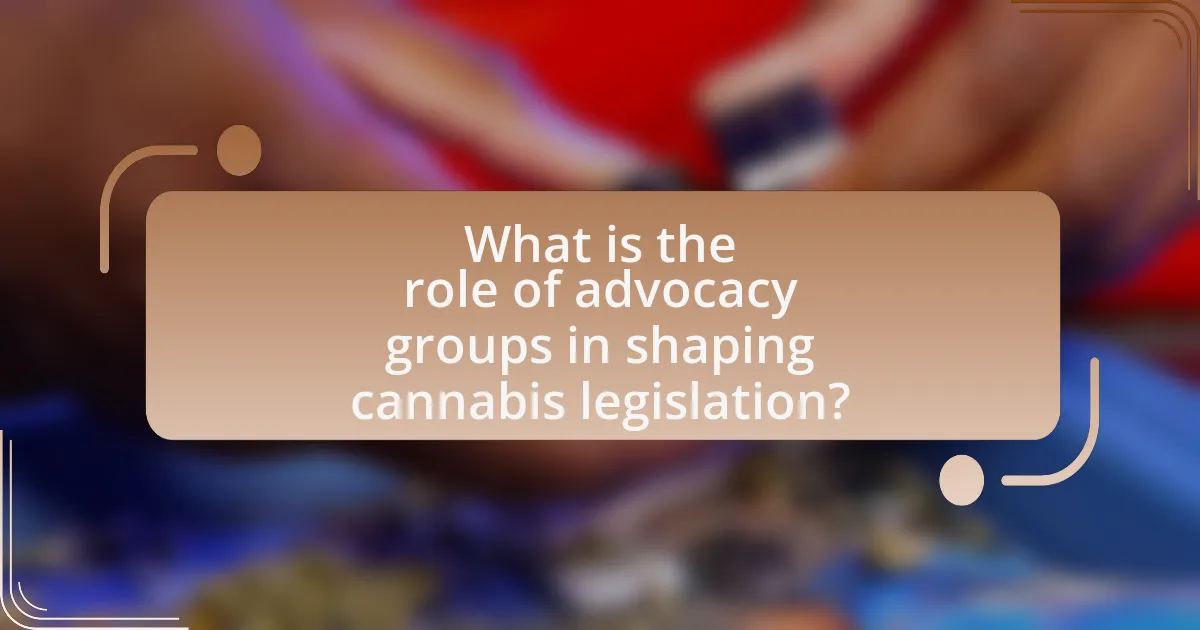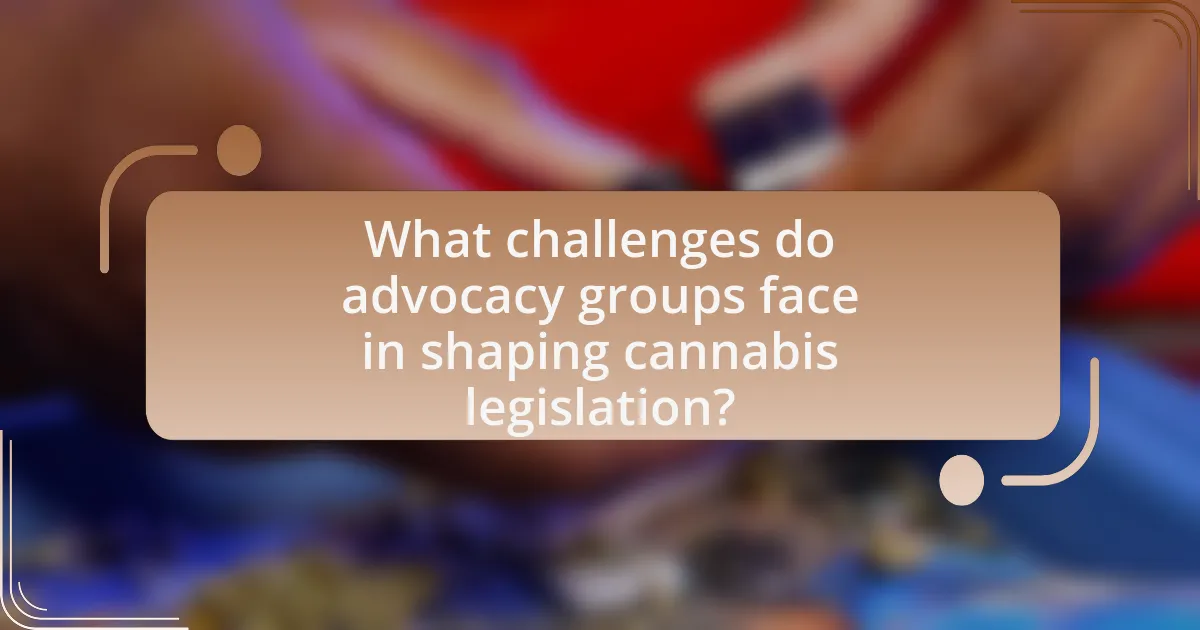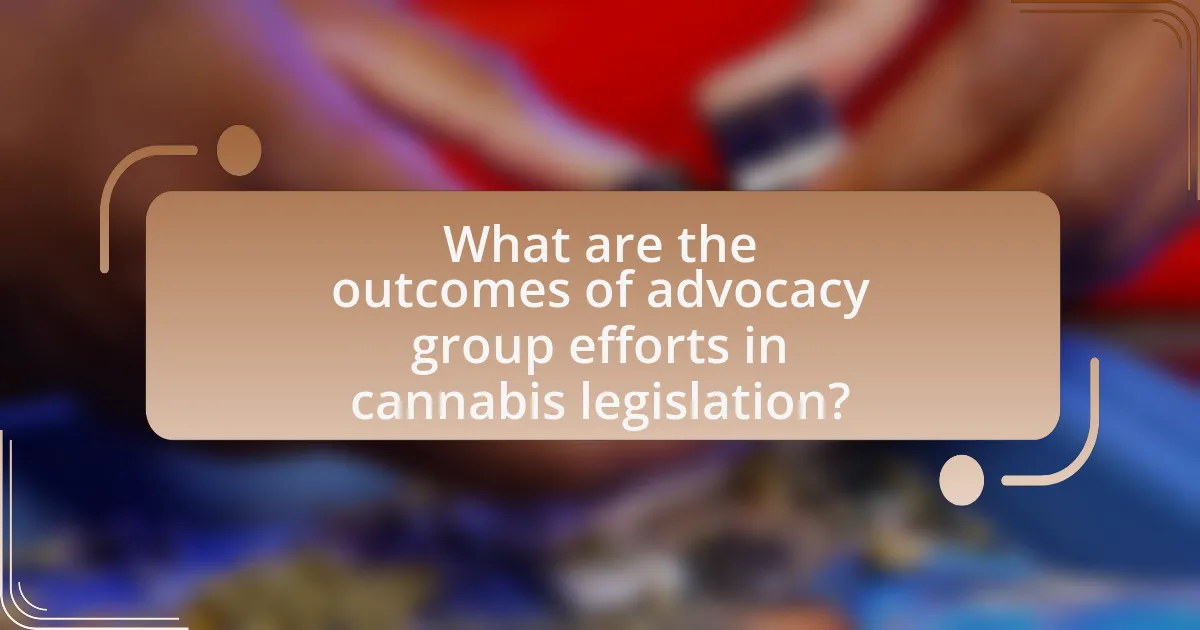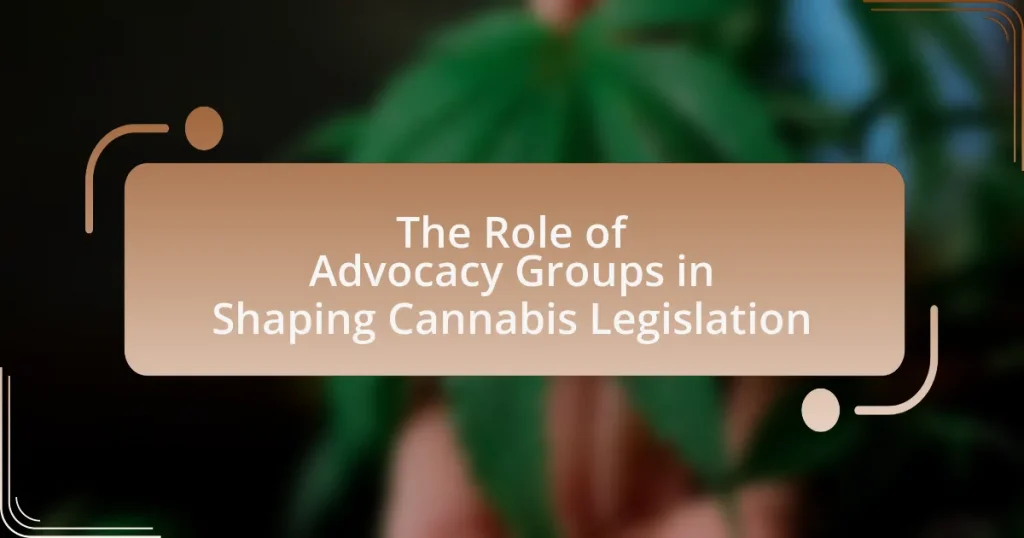Advocacy groups play a pivotal role in shaping cannabis legislation by mobilizing public support, influencing policymakers, and providing research-based evidence. Organizations such as the National Organization for the Reform of Marijuana Laws (NORML) and the Marijuana Policy Project have successfully advocated for the legalization and reform of cannabis laws across various states, utilizing strategies like grassroots mobilization and coalition building. These groups also work to shift public perception by countering misinformation and promoting the benefits of cannabis, while facing challenges such as political opposition and funding limitations. The article examines the objectives, strategies, and outcomes of advocacy efforts in cannabis legislation, highlighting the impact of public perception and collaboration on legislative success.

What is the role of advocacy groups in shaping cannabis legislation?
Advocacy groups play a crucial role in shaping cannabis legislation by mobilizing public support, influencing policymakers, and providing research-based evidence to inform legislative decisions. These organizations often engage in grassroots campaigns, lobbying efforts, and public education initiatives to raise awareness about the benefits of cannabis legalization and reform. For instance, the National Organization for the Reform of Marijuana Laws (NORML) has been instrumental in advocating for changes in cannabis laws across various states, contributing to the legalization of cannabis in over 20 states for recreational use as of 2023. Their efforts include organizing rallies, conducting research on cannabis benefits, and collaborating with lawmakers to draft legislation, thereby directly impacting the legal landscape surrounding cannabis.
How do advocacy groups influence public perception of cannabis?
Advocacy groups influence public perception of cannabis by actively promoting education, awareness, and policy change regarding its benefits and risks. These organizations often conduct campaigns that disseminate research findings, personal testimonials, and expert opinions to counteract stigma and misinformation surrounding cannabis use. For instance, the National Organization for the Reform of Marijuana Laws (NORML) has played a significant role in shifting public attitudes by providing data that highlights the medicinal benefits of cannabis, which has contributed to increased public support for legalization efforts. Additionally, advocacy groups engage in grassroots mobilization, encouraging community involvement and dialogue, which further shapes perceptions and fosters a more informed public discourse on cannabis.
What strategies do advocacy groups use to change public opinion?
Advocacy groups employ several strategies to change public opinion, including grassroots mobilization, targeted messaging, and coalition building. Grassroots mobilization involves engaging community members to participate in campaigns, which can amplify voices and create a sense of urgency around issues. Targeted messaging focuses on crafting specific narratives that resonate with different demographics, utilizing social media and traditional media to disseminate information effectively. Coalition building brings together various stakeholders, such as other advocacy groups, businesses, and influential figures, to present a united front and enhance credibility. For instance, the Marijuana Policy Project has successfully used these strategies to shift public perception on cannabis legalization, resulting in significant legislative changes across multiple states.
How does public perception impact cannabis legislation?
Public perception significantly impacts cannabis legislation by influencing policymakers and shaping the legal landscape surrounding cannabis use. When public opinion shifts towards favoring legalization or decriminalization, legislators are more likely to respond by introducing or supporting laws that reflect these views. For instance, a 2021 Gallup poll indicated that 68% of Americans supported legalizing cannabis, which has led to numerous states enacting more progressive cannabis laws. Advocacy groups play a crucial role in this process by mobilizing public support, educating communities, and lobbying for legislative changes, thereby directly linking public sentiment to the evolution of cannabis policy.
What are the key objectives of advocacy groups in cannabis reform?
The key objectives of advocacy groups in cannabis reform include promoting legalization, ensuring equitable access, and influencing policy changes. Advocacy groups aim to legalize cannabis for medical and recreational use, as evidenced by successful ballot initiatives in states like Colorado and California. They also focus on ensuring that marginalized communities have equitable access to the cannabis market, addressing historical injustices related to drug enforcement. Furthermore, these groups work to influence legislation by lobbying lawmakers and educating the public about the benefits of reform, which has been shown to shift public opinion in favor of legalization, as seen in various national surveys.
What specific legislative changes do advocacy groups aim for?
Advocacy groups aim for specific legislative changes such as the legalization of cannabis for both medical and recreational use, the expungement of criminal records related to cannabis offenses, and the establishment of regulations for safe production and distribution. These changes are pursued to promote social justice, public health, and economic opportunities within the cannabis industry. For instance, the Marijuana Policy Project has successfully influenced legislation in several states, leading to the legalization of cannabis in places like California and Colorado, demonstrating the effectiveness of advocacy efforts in shaping cannabis laws.
How do advocacy groups prioritize their goals in cannabis legislation?
Advocacy groups prioritize their goals in cannabis legislation by assessing public opinion, legal frameworks, and health impacts. These organizations often conduct surveys and research to identify the most pressing issues for their constituents, such as legalization, decriminalization, or medical access. For instance, the National Organization for the Reform of Marijuana Laws (NORML) focuses on legalizing cannabis based on public support and legislative opportunities, which is evidenced by their tracking of state-level reforms and voter initiatives. Additionally, advocacy groups analyze the potential health benefits and risks associated with cannabis use to inform their priorities, ensuring that their goals align with both public health data and community needs.
Why is collaboration important for advocacy groups in this context?
Collaboration is crucial for advocacy groups in shaping cannabis legislation because it amplifies their collective voice and enhances their influence on policy decisions. When advocacy groups unite, they can pool resources, share expertise, and create a more comprehensive strategy that addresses various aspects of cannabis legislation, such as public health, criminal justice reform, and economic impact. For instance, a coalition of groups can present a unified front during legislative hearings, increasing the likelihood of lawmakers taking their concerns seriously. Research shows that collaborative efforts in advocacy lead to more effective campaigns, as evidenced by the successful legalization initiatives in states like Colorado and California, where multiple organizations worked together to educate the public and lobby for change.
What partnerships do advocacy groups form to enhance their influence?
Advocacy groups form partnerships with various stakeholders, including other non-profit organizations, governmental agencies, and private sector entities, to enhance their influence in shaping cannabis legislation. These collaborations allow advocacy groups to pool resources, share expertise, and amplify their messaging, thereby increasing their reach and effectiveness. For instance, partnerships with medical associations can lend credibility to advocacy efforts by highlighting the health benefits of cannabis, while alliances with legal experts can provide insights into regulatory frameworks. Such strategic partnerships have been instrumental in advancing legislative changes, as evidenced by the successful legalization efforts in states like California and Colorado, where coalitions of advocacy groups worked together to mobilize public support and influence policymakers.
How does collaboration with other organizations strengthen advocacy efforts?
Collaboration with other organizations strengthens advocacy efforts by pooling resources, expertise, and networks to amplify the message and reach a broader audience. When advocacy groups unite, they can share data, strategies, and best practices, which enhances their effectiveness in influencing policy. For instance, a coalition of cannabis advocacy groups can leverage combined membership numbers to demonstrate widespread support for legislative changes, making it harder for policymakers to ignore their demands. Research shows that collaborative efforts can lead to more successful campaigns; a study by the Center for American Progress found that coalitions are 50% more likely to achieve their policy goals compared to isolated organizations.

What challenges do advocacy groups face in shaping cannabis legislation?
Advocacy groups face significant challenges in shaping cannabis legislation, primarily due to political opposition and varying public perceptions. Political opposition often stems from entrenched views among lawmakers who may prioritize traditional drug policies over reform, leading to legislative gridlock. Additionally, advocacy groups encounter difficulties in mobilizing public support, as misconceptions about cannabis persist, influencing voter attitudes and legislative outcomes. For instance, a 2021 Gallup poll indicated that while support for legalization has reached 68%, significant portions of the population still hold negative views, complicating advocacy efforts. Furthermore, funding limitations restrict the capacity of these groups to effectively campaign and lobby for change, impacting their overall influence in the legislative process.
How do legal and political barriers affect advocacy efforts?
Legal and political barriers significantly hinder advocacy efforts by restricting the ability of groups to mobilize support and influence policy changes. For instance, stringent regulations on lobbying and campaign financing can limit the resources available to advocacy organizations, thereby reducing their effectiveness in promoting cannabis legislation. Additionally, political opposition from lawmakers can create an environment where advocacy efforts are met with hostility, making it difficult for groups to gain traction. Historical examples, such as the challenges faced by organizations advocating for cannabis legalization in states with strict drug laws, illustrate how these barriers can stifle progress and limit public discourse on the issue.
What specific legal challenges do advocacy groups encounter?
Advocacy groups encounter specific legal challenges such as navigating complex regulatory frameworks, facing opposition from established industries, and dealing with litigation risks. These challenges arise primarily from the evolving nature of cannabis legislation, which varies significantly across jurisdictions. For instance, advocacy groups often struggle with compliance issues related to state and federal laws that can conflict, as seen in the ongoing tension between state-legal cannabis markets and federal prohibition in the United States. Additionally, established industries may lobby against cannabis legalization efforts, creating legal hurdles for advocacy groups attempting to influence policy. Furthermore, litigation risks can arise from challenges to the legality of their activities or from opposition groups seeking to undermine their efforts, as evidenced by various lawsuits filed against advocacy organizations in states where cannabis reform is being pursued.
How do political climates influence the effectiveness of advocacy groups?
Political climates significantly influence the effectiveness of advocacy groups by determining the level of support or opposition these groups encounter in their efforts. For instance, in a politically favorable environment, advocacy groups can leverage supportive legislation and public sentiment to advance their agendas, as seen in states where cannabis legalization has gained traction due to shifting public attitudes and political backing. Conversely, in a hostile political climate, advocacy groups may face legislative barriers, reduced funding, and increased scrutiny, which can hinder their ability to mobilize support and achieve their goals. Historical examples include the rapid legalization of cannabis in states like Colorado and California, where progressive political climates facilitated advocacy efforts, contrasting with states where conservative leadership has stalled similar initiatives.
What role does funding play in the success of advocacy groups?
Funding is crucial for the success of advocacy groups as it enables them to effectively promote their causes, engage in outreach, and influence policy decisions. Adequate financial resources allow these organizations to hire skilled staff, conduct research, and mobilize grassroots efforts, which are essential for raising awareness and driving legislative change. For instance, a study by the Center for Responsive Politics found that advocacy groups with higher funding levels are more likely to achieve their policy goals, as they can invest in comprehensive campaigns and strategic lobbying efforts. This financial backing directly correlates with their ability to sustain operations and amplify their message in the competitive landscape of policy advocacy, particularly in complex areas like cannabis legislation.
How do advocacy groups secure funding for their initiatives?
Advocacy groups secure funding for their initiatives primarily through donations, grants, and fundraising events. These organizations often rely on contributions from individual supporters, which can be significant; for instance, the American Civil Liberties Union reported receiving over $100 million in donations in a single year. Additionally, many advocacy groups apply for grants from foundations and government entities that align with their missions, such as the Drug Policy Alliance, which has received substantial funding to support cannabis reform efforts. Fundraising events, including auctions and awareness campaigns, also play a crucial role in generating financial support, allowing these groups to mobilize resources effectively for their initiatives.
What impact does funding have on the reach and effectiveness of advocacy efforts?
Funding significantly enhances the reach and effectiveness of advocacy efforts by providing necessary resources for outreach, research, and mobilization. For instance, advocacy groups with substantial funding can employ professional staff, conduct comprehensive studies, and launch extensive public awareness campaigns, which directly influence public opinion and policy decisions. A study by the Center for American Progress found that organizations with higher funding levels were able to engage more effectively with policymakers and the public, resulting in a greater likelihood of achieving legislative goals. Thus, adequate funding is crucial for advocacy groups aiming to shape cannabis legislation effectively.
How do advocacy groups address opposition to cannabis legislation?
Advocacy groups address opposition to cannabis legislation by employing strategic communication, grassroots mobilization, and coalition-building efforts. These organizations often counteract misinformation by providing factual data on the benefits of cannabis legalization, such as its medical uses and potential economic advantages, which can include job creation and tax revenue. For instance, the National Organization for the Reform of Marijuana Laws (NORML) has consistently highlighted studies showing reduced opioid prescriptions in states with legal cannabis, thereby framing legalization as a public health benefit. Additionally, advocacy groups engage in lobbying efforts to influence policymakers and public opinion, utilizing campaigns that emphasize personal stories from individuals positively impacted by cannabis access. This multifaceted approach aims to shift perceptions and build broader support for cannabis legislation.
What tactics do advocacy groups use to counteract negative narratives?
Advocacy groups counteract negative narratives by employing strategies such as public education campaigns, strategic partnerships, and leveraging social media. Public education campaigns aim to inform the public about the benefits of cannabis legalization, using data from studies that show reduced crime rates and increased tax revenue in states where cannabis is legal. Strategic partnerships with health organizations and influential figures help to enhance credibility and reach broader audiences. Additionally, advocacy groups utilize social media platforms to disseminate positive stories and counter misinformation, effectively engaging with the community and shaping public perception.
How do advocacy groups engage with opponents of cannabis reform?
Advocacy groups engage with opponents of cannabis reform through dialogue, education, and coalition-building. These groups often initiate conversations to understand the concerns of opponents, providing factual information about the benefits of cannabis reform, such as economic growth and public health improvements. For instance, studies have shown that legalizing cannabis can lead to increased tax revenue, which advocacy groups highlight to counteract fiscal concerns raised by opponents. Additionally, advocacy groups may collaborate with unlikely allies, including law enforcement and health professionals, to present a united front that addresses safety and regulatory issues, thereby fostering a more constructive discourse around cannabis reform.

What are the outcomes of advocacy group efforts in cannabis legislation?
Advocacy group efforts in cannabis legislation have led to significant policy changes, including the legalization of cannabis in various states and the decriminalization of its use. For instance, organizations like the Marijuana Policy Project have successfully influenced legislation in states such as Colorado and California, resulting in the legalization of recreational cannabis in 2012 and 2016, respectively. These outcomes are supported by public opinion shifts, with a Gallup poll in 2021 indicating that 68% of Americans support legalizing cannabis, reflecting the impact of advocacy on societal attitudes and legislative action.
How have advocacy groups successfully influenced cannabis laws?
Advocacy groups have successfully influenced cannabis laws by mobilizing public support, conducting research, and lobbying policymakers. For instance, organizations like the Marijuana Policy Project have played a crucial role in changing public perception through educational campaigns, which contributed to the legalization of cannabis in several states. Additionally, these groups often provide data and research that highlight the benefits of legalization, such as economic growth and reduced incarceration rates, which lawmakers consider when drafting legislation. In 2020, a study by the American Civil Liberties Union indicated that states with active advocacy groups saw a 20% increase in cannabis legalization efforts compared to those without such organizations.
What notable legislative victories can be attributed to advocacy groups?
Notable legislative victories attributed to advocacy groups in cannabis legislation include the legalization of recreational marijuana in states like Colorado and Washington. These victories were achieved through extensive grassroots campaigns led by organizations such as the Marijuana Policy Project and the Drug Policy Alliance, which mobilized public support and lobbied lawmakers. For instance, Colorado’s Amendment 64, passed in 2012, was a direct result of advocacy efforts that highlighted the economic benefits and social justice implications of legalization. Additionally, advocacy groups played a crucial role in the passage of the 2018 Farm Bill, which legalized hemp-derived CBD, further demonstrating their influence in shaping cannabis policy at both state and federal levels.
How do these victories impact communities and stakeholders?
Victories in cannabis legislation significantly impact communities and stakeholders by fostering economic growth and enhancing social equity. For instance, the legalization of cannabis has led to increased tax revenues, which can be allocated to public services such as education and healthcare, benefiting the community at large. Additionally, advocacy groups often push for provisions that address social justice, such as expunging criminal records for past cannabis offenses, which directly aids individuals and communities disproportionately affected by previous drug policies. According to a report by the Marijuana Policy Project, states that have legalized cannabis have seen a 20% increase in tax revenue, demonstrating the financial benefits for local governments and communities.
What metrics are used to evaluate the success of advocacy groups?
Advocacy groups are evaluated based on metrics such as policy changes, public awareness, membership growth, and funding levels. Policy changes indicate the effectiveness of advocacy efforts in influencing legislation, while public awareness can be measured through media coverage and public opinion polls. Membership growth reflects the group’s ability to mobilize support, and funding levels demonstrate financial sustainability and capacity to execute initiatives. For instance, a study by the Center for American Progress found that advocacy groups that successfully mobilized grassroots support saw a 30% increase in legislative wins over a five-year period.
How do advocacy groups measure their influence on legislation?
Advocacy groups measure their influence on legislation through various methods, including tracking legislative outcomes, analyzing voting patterns, and assessing public opinion shifts. These groups often monitor specific bills and amendments to determine if their lobbying efforts resulted in favorable changes or the passage of legislation aligned with their goals. For instance, the National Organization for the Reform of Marijuana Laws (NORML) evaluates its impact by examining the number of states that have legalized cannabis following their campaigns, which provides concrete evidence of their effectiveness in shaping cannabis legislation. Additionally, surveys and polls conducted by advocacy groups can quantify changes in public sentiment regarding cannabis policies, further illustrating their influence on legislative processes.
What indicators show the effectiveness of advocacy campaigns?
Indicators that show the effectiveness of advocacy campaigns include changes in public opinion, legislative outcomes, and increased media coverage. For instance, a measurable shift in public support for cannabis legalization can indicate successful advocacy efforts, as seen in various polls conducted before and after major campaigns. Legislative outcomes, such as the passage of laws or amendments that align with advocacy goals, serve as direct evidence of effectiveness; for example, the legalization of cannabis in several states following targeted advocacy initiatives. Additionally, increased media coverage of cannabis issues often correlates with advocacy success, as it reflects heightened public interest and awareness driven by campaign efforts.
What best practices can advocacy groups adopt for future efforts?
Advocacy groups can adopt data-driven strategies to enhance their future efforts in shaping cannabis legislation. By utilizing empirical research and statistics, these groups can present compelling arguments that resonate with policymakers and the public. For instance, studies have shown that states with legalized cannabis have seen a significant increase in tax revenue, which can be a persuasive point for legislative change. Additionally, advocacy groups should engage in coalition-building with other organizations to amplify their voice and reach a broader audience. Collaborating with diverse stakeholders can strengthen their position and create a united front for legislative initiatives. Furthermore, leveraging social media platforms for awareness campaigns can effectively mobilize grassroots support, as evidenced by the rapid spread of information during recent cannabis legalization movements. These best practices, grounded in evidence and collaboration, can significantly enhance the impact of advocacy groups in future legislative efforts.
How can advocacy groups improve their outreach strategies?
Advocacy groups can improve their outreach strategies by leveraging data-driven approaches to identify target demographics and tailor messaging accordingly. Utilizing analytics tools allows these groups to assess the effectiveness of their campaigns, ensuring that resources are allocated efficiently. For instance, a study by the Pew Research Center found that targeted social media campaigns can increase engagement rates by up to 50%, demonstrating the importance of understanding audience preferences. Additionally, forming partnerships with local organizations can enhance credibility and expand reach, as evidenced by successful coalitions in various states that have effectively mobilized community support for cannabis legislation.
What lessons have been learned from past advocacy campaigns in cannabis legislation?
Past advocacy campaigns in cannabis legislation have demonstrated the importance of building broad coalitions and engaging diverse stakeholders. Successful campaigns, such as those in Colorado and Washington, highlighted that inclusive strategies, which involve not only cannabis users but also health professionals, law enforcement, and community leaders, can effectively shift public opinion and influence policymakers. For instance, the Colorado campaign in 2012 utilized a coalition of various groups, resulting in a 55% approval rate for legalization. Additionally, these campaigns revealed the necessity of clear, factual messaging that addresses public concerns about safety and health, as evidenced by the emphasis on regulation and taxation in successful initiatives.


